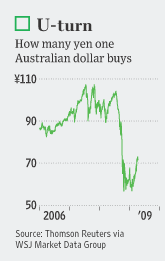
Traditionally, the most popular long currencies were those
of industrialized countries, rich in commodities and backed
by high interest rates and often rich in commodities. To be
sure, these currencies have shined in recent months, certainly
due in part to speculative (carry) trading.
“
Strategists at Wells Fargo Bank in New York
‘believe that the gains in the dollar-bloc currencies
(Australia, New Zealand, Canada) have run ahead
of the gains in commodity prices.’ ”
The Bank of Canada also noticed that “At the time of its last statement,
oil prices were about $75 a barrel, but now they are
in the $60-to-$65 range. That suggests the currency’s
appreciation has outpaced the demand for its commodity exports.”
But the run-ups in the Kiwi, Aussie, and Loonie have been
overshadowed by even more rapid appreciation in
emerging market currencies. This shift is largely a product
of changes in interest rate differentials, which are now
gapingly large between developed countries and developing
countries. Compare the 2.75%+ spread between the US and
Australia, with the 8.5% spread between the US and Brazil or
12.75% between the US and Russia. For investors once again
becoming complacent about risk, the choice is a no-brainer.
Still, some analysts are nervous about this change in dynamic:
“While the new carry trade may be less leveraged, it’s an
inherently
riskier bet. As such, it’s more vulnerable to the kind
of swift unraveling of risk appetite observed across all nations
and sectors in 2008, but which occurs with far more frequency in
emerging markets.” Meanwhile, emerging market stocks have
behaved volatilely over the last few weeks (with Chinese stocks
even entering bear market territory), and some investors are
concerned that they may be temporarily peaking. There are also
signs that bubbles may be forming in carry trade currencies,
with bullish sentiment at high levels. Accordingly, one strategist
suggests waiting out a 5% pullback in the Australian dollar, and
a 10% pullback in the New Zealand dollar before going back in.
There is also the outside possibility that the Fed will raise
interest rates, which would crimp the viability of the US Dollar
as a funding currency.
Granted, it seems unlikely that the Fed will tighten within the
next six months, but investors with a longer time horizon could
begin to adjust their positions now, rather than wait until the 11th hour,
at which point everyone will be rushing for the exits.

0 comments:
Post a Comment